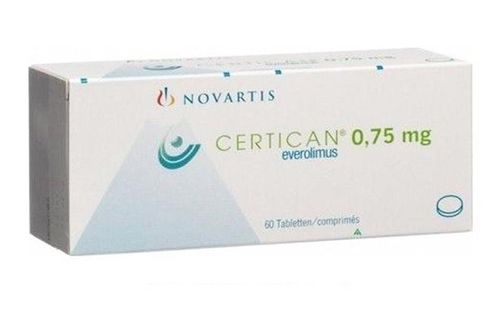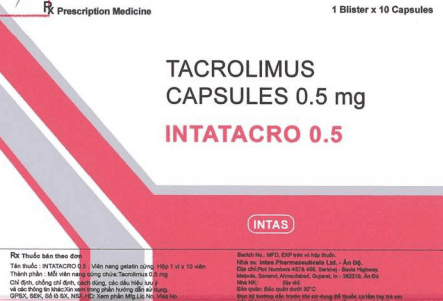This is an automatically translated article.
Cellcept drug is often applied to cases where it is necessary to prevent rejection after transplanting organs into the body such as kidney, heart or liver. During the use of Cellcept, all doctor's recommendations about dosage and time of taking the drug should be strictly followed to help patients avoid other health risks.
1. What is Cellcept?
Cellcept drug belongs to the group of drugs that suppress the immune system, providing effects based on the mechanism of blocking the activities of the immune system. Therefore, Cellcept is often used to prevent the rejection of transplanted organs such as the heart, liver or kidneys.Cellcept is a product of Roche S.P.A - Italy, made in the form of tablets and packaged in a box of 5 blisters x 10 tablets. Each Cellcept tablet contains the following pharmaceutical ingredients:
Main active ingredient: Mycophenolate mofetil 250mg or 500mg. Other excipients are sufficient for 1 tablet. The main active ingredient Mycophenolate mofetil acts as a selective inhibitor of the enzyme IMDH, capable of inhibiting the synthesis of purine nuclei, which is essential for the formation of T and B lymphocytes, without the need to enter DNA. . Thanks to this mechanism, the active ingredient Mycophenolate in Cellcept can inhibit the functioning of B and T cells. This helps prevent the body from eliminating foreign agents that are newly transplanted organs into the body. patient body.
2. Indications and contraindications to the use of Cellcept
2.1 Indications for use of Cellcept drug Cellcept drug is often used to prevent rejection reactions in subjects who have received organ transplants such as heart, kidney or liver. Cellcept drug should be used in combination with Corticosteroids and Cyclosporine.
2.2 Contraindications to using Cellcept drug Do not use Cellcept drug for the following subjects:
Patients with a history of hypersensitivity or allergy to Mycophenolate mofetil, Mycophenolic acid or any other active ingredients in the drug. Cellcept is contraindicated in women who plan to become pregnant or are pregnant. Cellcept is contraindicated in cases of ineffective contraception. Cellcept is contraindicated in women who are breastfeeding.
3. Dosage and how to use Cellcept
3.1. Dosage of Cellcept drug Below is the dose of Cellcept drug to prevent transplant rejection for each patient as recommended by the doctor:
Dose for prevention of transplant rejection: Take 2g/day. Dose for kidney transplant patients: Take 2g/day. If it is necessary to enhance the suppressive effect of the immune system, it can be considered up to 3g/day. Dose for liver transplant patients: Take 1.5g/day, orally 2 times/day. Dose for heart transplant patients: Take 1.5g/day, orally 2 times/day within 5 days after surgery. Administer the first dose within 72 hours of the patient having an organ transplant. For patients with severe renal impairment with creatinine clearance < 25ml/min, doses higher than 1g/day should be avoided. For patients with slow-functioning grafts, the dose of Cellcept will need to be adjusted to be most appropriate. 3.2 Instructions for proper use of Cellcept Before using Cellcept, patients need to consult their doctor about the appropriate dosage for their transplant condition. Because Cellcept is made in tablet form, patients should take it by swallowing the tablet whole, avoiding chewing or crushing it.
Cellcept drug is not affected by food or drink, so the use of the drug does not need to be considered before or after a meal. In addition, in the process of preventing transplant rejection with Cellcept, patients need to take the right dose and at the correct time as prescribed by the doctor.
4. Possible side effects when taking Cellcept
During the prevention of transplant rejection with Cellcept, patients may inadvertently experience some of the following undesirable side effects:
Pleural effusion. Stomachache. Diarrhea. Nausea or vomiting. Cough or difficulty breathing. Peritonitis, colitis, peptic ulcer, stomatitis, esophagitis, gastrointestinal bleeding, belching, intestinal obstruction, dyspepsia or flatulence. Vasodilation. Raise/lower blood pressure. Confusion. Excitement. Anxiety/depression, unusual thoughts. Insomnia. Hyper or hypokalemia, hypomagnesaemia, hypercholesterolemia, hypocalcemia, hyperglycemia, hyperlipidemia, hyperuricemia/blood phosphate. Gout . Anorexia. Metabolic acidosis. Sepsis. Urinary tract infections, Herpes Zoster / Simplex infections, Candida infections of the digestive system. Benign skin tumor or skin cancer. Respiratory tract infections, pneumonia, laryngitis, bronchitis, sinusitis, rhinitis. Vaginal/skin candidiasis. The above is not a complete list of possible side effects while taking Cellcept, patients still have a risk of experiencing some other symptoms not mentioned. If you notice any unusual reactions after taking Cellcept, please proactively notify your doctor for a solution.
5. Things to keep in mind when preventing transplant rejection with Cellcept
5.1 What precautions should be taken while using Cellcept? Before deciding to use Cellcept to prevent transplant rejection, patients should inform their doctor if:
Have ever been allergic to any of the active ingredients in Cellcept. Pregnant/breastfeeding. Are allergic to chemicals, foods, dyes, or animals. Having any other health problems such as fever, sore throat, bruises, unexpected bleeding, stomach ulcers, etc. In addition, patients also need to keep a few things in mind after starting the treatment. Cellcept drug treatment:
Cellcept drug can reduce the ability of immunosuppression when there is the impact of sunlight, which easily increases the risk of skin cancer. Therefore, when using Cellcept, patients need to protect their skin carefully from ultraviolet rays by applying sunscreen or wearing protective clothing. Patients with diseases of the gastrointestinal tract should be cautious when using Cellcept. Patients after organ transplantation who show slow recovery of kidney function should also be careful when using Cellcept. If the body has a deficiency of the enzyme Hypoxanthine-Guaninephosphoribosyl-Transferase (HGPRT) due to genetic factors, the patient should carefully consult a specialist before deciding to take Cellcept. Patients with Lesch-Nyhan & Kelley-Seegmiller syndrome should also use caution when using Cellcept. Blood counts should be checked once a week during the first month of Cellcept treatment, then maintained once a month. Care should be taken when using Cellcept in patients with specific occupations such as operating machinery or driving vehicles. 5.2 What drugs can interact with Cellcept? Cellcept drugs when combined with other drugs can change the mechanism of action or increase the side effects of the drug. To minimize the risk of drug-drug interactions, it's always a good idea to talk to your doctor about any medications you're currently taking, including herbs, vitamins, and health-promoting foods. Here are some drugs that can interact with Cellcept:
Proton pump inhibitors. Antiviral drugs such as Ganciclovir and Acyclovir. Medications to treat dyslipidemia such as Sevelamer or Cholestyramine. Drugs that suppress the immune system, such as Tacrolimus or Cyclosporin A. Drugs that affect enterohepatic circulation. Oral contraceptives. Vaccines - live. Telmisartan medicine. Rifampicin drug. Metronidazole or Norfloxacin. Sulfamethoxazole or Trimethoprim. Amoxicillin, Clavulanic Acid, or Ciprofloxacin. Cellcept is often used to prevent transplant rejection after organ transplantation such as kidney, heart or liver. Strictly following the instructions will bring the most effective treatment.
Follow Vinmec International General Hospital website to get more health, nutrition and beauty information to protect the health of yourself and your loved ones in your family.
Please dial HOTLINE for more information or register for an appointment HERE. Download MyVinmec app to make appointments faster and to manage your bookings easily.













